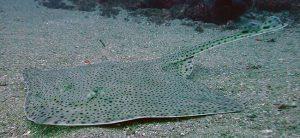Rays (Rajiformes) are an order belonging to the sub-class of Elasmobranchs, characterized like all Chondrichthyte species, by a cartilaginous body. They are closely related to sharks, with whom they share the general structure of the skeleton and some other features such as number and type of fins and morphology of gill slits. Rays are mainly marine species, with a very wide distribution. From the Arctic to the Antarctic, and from the coast to open seas. They inhabit almost all the seas of the world, although it is also true that there are species that penetrate the rivers. Generally they are species that usually inhabit waters near the coast and as they grow they go into deeper waters. The largest species of ray known today is the manta ray (Manta birostris) which can reach a total length of more than 5 meters.
The characteristic body shape of the rays consists of a very flattened body dorsally, with the eyes lacking nictitating membrane and located in the dorsal part of the body. It is worth noting from their eyes, that their corneas are attached directly to the skin around the eyes, a very characteristic feature. Next to the eyes, we will find a pair of spiracles, small orifices or vestigial gill openings, associated to the respiratory system of the animal, and through which it captures the water that redirects the gills to allow breathing. Also associated with respiration, the rays have gill slits located in the ventral position of the body and prior to the birth of the pectoral fins. The mouth of the rays is also in the ventral position, with generally projectile jaws armed with numerous flattened teeth that act as a crusher and are extremely effective in breaking the shell of the Crustaceans and Molluscs on which it feeds. In the frontal region of the body, rays can possess sensors capable of detecting minute electrical impulses. This sensory capacity allows them to detect possible prey that is buried in the sand, just by swimming over the bottom. Once located, they position their body above the place on the bottom where they have detected the signal, and with undulating movements of their fins, they dig up their prey by quickly gobbling it up with their mouth. At the back of the body, we usually find a slender tail. At its base or in the first third of its length, we can find an extremely sharp stinger and usually with serrated sides. Only 2 families of rays have associated these stingers with poison glands. In any case, and regardless of the presence or absence of poison, the stinger itself is used as a defense system that rays will not hesitate to use in dangerous situations, and can generate a considerable wound and tear in the victim. From time to time the stinger is replaced by a new one.
As for the fins of rays, these order of species is characterized by the absence of the anal fin. The pectoral fins have been attached to the trunk of the animal, thus forming a disc. The caudal fin is very variable depending on the species, having species with a moderately well developed caudal fin, to species with reduced or even absent caudal fins. Finally, the dorsal fins of rays, can either be absent or have up to 2.
Due to the body conformation of the rays, as we can easily deduce, they go very easily unnoticed in the sandy/muddy bottoms, since the extremely flattened shape, together with some movements of their undulating pectoral fins, allow them to cover their body entirely or partially with the same bottom. In this way the rays go completely unnoticed by possible prey that may pass through their vicinity.
The reproduction of the rays is also varied, with viviparous species that give birth to completely autonomous offspring, to oviparous species that put their embryos wrapped in a horny capsule, whose 4 corners adopt elongated structures, and which together are called mermaid bags.
At present all the species of rays are organized in 1 family, which contains 32 genuses, and in which in total they include 287 species of rays.

